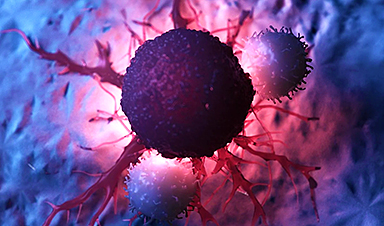A new study reveals that blocking ribosomal RNA production rewires cancer cell behavior and could help treat genetically unstable tumors.
Researchers at the Johns Hopkins Kimmel Cancer Center and the Department of Radiation Oncology and Molecular Radiation Sciences have identified a tumor-suppressive response that could lead to new treatments for cancers that are difficult to treat.
In a study published June 18 in Cell Chemical Biology and partially funded by the National Institutes of Health, the team showed that interfering with a key step in protein production can inhibit cancer cell growth. The research also explains why certain cancer cells are particularly sensitive to this approach. These findings point to new therapeutic strategies for cancers with common genetic mutations.
The team discovered that blocking RNA Polymerase 1 (Pol 1), the enzyme responsible for transcribing human ribosomal RNA (rRNA), triggers a unique stress response. This response alters RNA splicing—the process by which cells generate different forms of proteins—and leads to tumor suppression. Ribosomal RNA genes are crucial for building ribosomes, the cellular machinery responsible for translating proteins.
A surprising role for RPL22 in RNA splicing
"Ribosome biogenesis has long been known as a hallmark of cancer," says study leader Marikki Laiho, M.D., Ph.D., the Willard and Lillian Hackerman Professor of Radiation Oncology and Vice Chair for Research of the Department of Radiation Oncology and Molecular Radiation Sciences. "Our study reveals that the ribosomal protein RPL22, typically a structural component of the ribosome, plays an unexpected dual role as a critical regulator of RNA splicing."
In 2014, Marikki Laiho and her team identified RNA Polymerase 1 (Pol 1) as a promising therapeutic target for cancer treatment. She began laboratory research using human cell lines to test a small molecule called BMH-21. This compound was developed in collaboration with James Barrow, Ph.D., a pharmacology and molecular sciences expert at Johns Hopkins, to block Pol 1 activity.

In their most recent study, the team examined more than 300 cancer cell lines and found that tumors with mutations in the gene RPL22, or with elevated levels of MDM4 and RPL22L1, were especially responsive to Pol 1 inhibitors like BMH-21 and a newly developed drug called BOB-42. These genetic changes are frequently found in cancers with mismatch repair deficiency, or MMRd, including colorectal, stomach, and uterine cancers. MMRd allows copying errors in DNA to go uncorrected during cell division, leading to a high number of mutations and a greater risk of cancer development.
Promising drug trial results in animals
The team tested the Pol 1 inhibitor BOB-42 in animal models, including patient-derived tumors containing the same key genetic markers. The drug reduced tumor growth by up to 77% in melanoma and colorectal cancers.
"These findings highlight a promising new path for targeting cancers, especially for patients with mismatch repair-deficient cancers that are resistant to existing therapies," says the study's first author, Wenjun Fan, Ph.D., research associate.
The study also suggests that changing how cancer cells splice RNA, or produce different forms of proteins, could affect how the immune system recognizes tumors. Combining immunotherapies with Pol 1 inhibitors may improve the effectiveness of immunotherapies.
"This is an entirely new conceptual framework for understanding how rRNA synthesis influences cancer cell behavior," says Laiho. "Targeting this pathway could not only suppress tumor growth but also modulate tumor antigenicity and enhance responsiveness to immunotherapies."
Reference: "Ribosomal RNA transcription regulates splicing through ribosomal protein RPL22" by Wenjun Fan, Hester Liu, Gregory C. Stachelek, Asma Begum, Catherine E. Davis, Tony E. Dorado, Glen Ernst, William C. Reinhold, Busra Ozbek, Qizhi Zheng, Angelo M. De Marzo, N.V. Rajeshkumar, James C. Barrow and Marikki Laiho, 18 June 2025, Cell Chemical Biology.
DOI: 10.1016/j.chembiol.2025.05.012
The research was funded by grants from the National Institutes of Health (R01 GM121404 and P30 CA006973), the National Cancer Institute (K99 CA279786), Blue One Biosciences LLC, Commonwealth Foundation, Mary Kay Ash Charitable Foundation, Academy of Finland (288364), Maryland Cigarette Restitution Fund, and Harrington Scholar-Q9 Innovator Award.
News
Nanomedicine in 2026: Experts Predict the Year Ahead
Progress in nanomedicine is almost as fast as the science is small. Over the last year, we've seen an abundance of headlines covering medical R&D at the nanoscale: polymer-coated nanoparticles targeting ovarian cancer, Albumin recruiting nanoparticles for [...]
Lipid nanoparticles could unlock access for millions of autoimmune patients
Capstan Therapeutics scientists demonstrate that lipid nanoparticles can engineer CAR T cells within the body without laboratory cell manufacturing and ex vivo expansion. The method using targeted lipid nanoparticles (tLNPs) is designed to deliver [...]
The Brain’s Strange Way of Computing Could Explain Consciousness
Consciousness may emerge not from code, but from the way living brains physically compute. Discussions about consciousness often stall between two deeply rooted viewpoints. One is computational functionalism, which holds that cognition can be [...]
First breathing ‘lung-on-chip’ developed using genetically identical cells
Researchers at the Francis Crick Institute and AlveoliX have developed the first human lung-on-chip model using stem cells taken from only one person. These chips simulate breathing motions and lung disease in an individual, [...]
Cell Membranes May Act Like Tiny Power Generators
Living cells may generate electricity through the natural motion of their membranes. These fast electrical signals could play a role in how cells communicate and sense their surroundings. Scientists have proposed a new theoretical [...]
This Viral RNA Structure Could Lead to a Universal Antiviral Drug
Researchers identify a shared RNA-protein interaction that could lead to broad-spectrum antiviral treatments for enteroviruses. A new study from the University of Maryland, Baltimore County (UMBC), published in Nature Communications, explains how enteroviruses begin reproducing [...]
New study suggests a way to rejuvenate the immune system
Stimulating the liver to produce some of the signals of the thymus can reverse age-related declines in T-cell populations and enhance response to vaccination. As people age, their immune system function declines. T cell [...]
Nerve Damage Can Disrupt Immunity Across the Entire Body
A single nerve injury can quietly reshape the immune system across the entire body. Preclinical research from McGill University suggests that nerve injuries may lead to long-lasting changes in the immune system, and these [...]
Fake Science Is Growing Faster Than Legitimate Research, New Study Warns
New research reveals organized networks linking paper mills, intermediaries, and compromised academic journals Organized scientific fraud is becoming increasingly common, ranging from fabricated research to the buying and selling of authorship and citations, according [...]
Scientists Unlock a New Way to Hear the Brain’s Hidden Language
Scientists can finally hear the brain’s quietest messages—unlocking the hidden code behind how neurons think, decide, and remember. Scientists have created a new protein that can capture the incoming chemical signals received by brain [...]
Does being infected or vaccinated first influence COVID-19 immunity?
A new study analyzing the immune response to COVID-19 in a Catalan cohort of health workers sheds light on an important question: does it matter whether a person was first infected or first vaccinated? [...]
We May Never Know if AI Is Conscious, Says Cambridge Philosopher
As claims about conscious AI grow louder, a Cambridge philosopher argues that we lack the evidence to know whether machines can truly be conscious, let alone morally significant. A philosopher at the University of [...]
AI Helped Scientists Stop a Virus With One Tiny Change
Using AI, researchers identified one tiny molecular interaction that viruses need to infect cells. Disrupting it stopped the virus before infection could begin. Washington State University scientists have uncovered a method to interfere with a key [...]
Deadly Hospital Fungus May Finally Have a Weakness
A deadly, drug-resistant hospital fungus may finally have a weakness—and scientists think they’ve found it. Researchers have identified a genetic process that could open the door to new treatments for a dangerous fungal infection [...]
Fever-Proof Bird Flu Variant Could Fuel the Next Pandemic
Bird flu viruses present a significant risk to humans because they can continue replicating at temperatures higher than a typical fever. Fever is one of the body’s main tools for slowing or stopping viral [...]
What could the future of nanoscience look like?
Society has a lot to thank for nanoscience. From improved health monitoring to reducing the size of electronics, scientists’ ability to delve deeper and better understand chemistry at the nanoscale has opened up numerous [...]





















